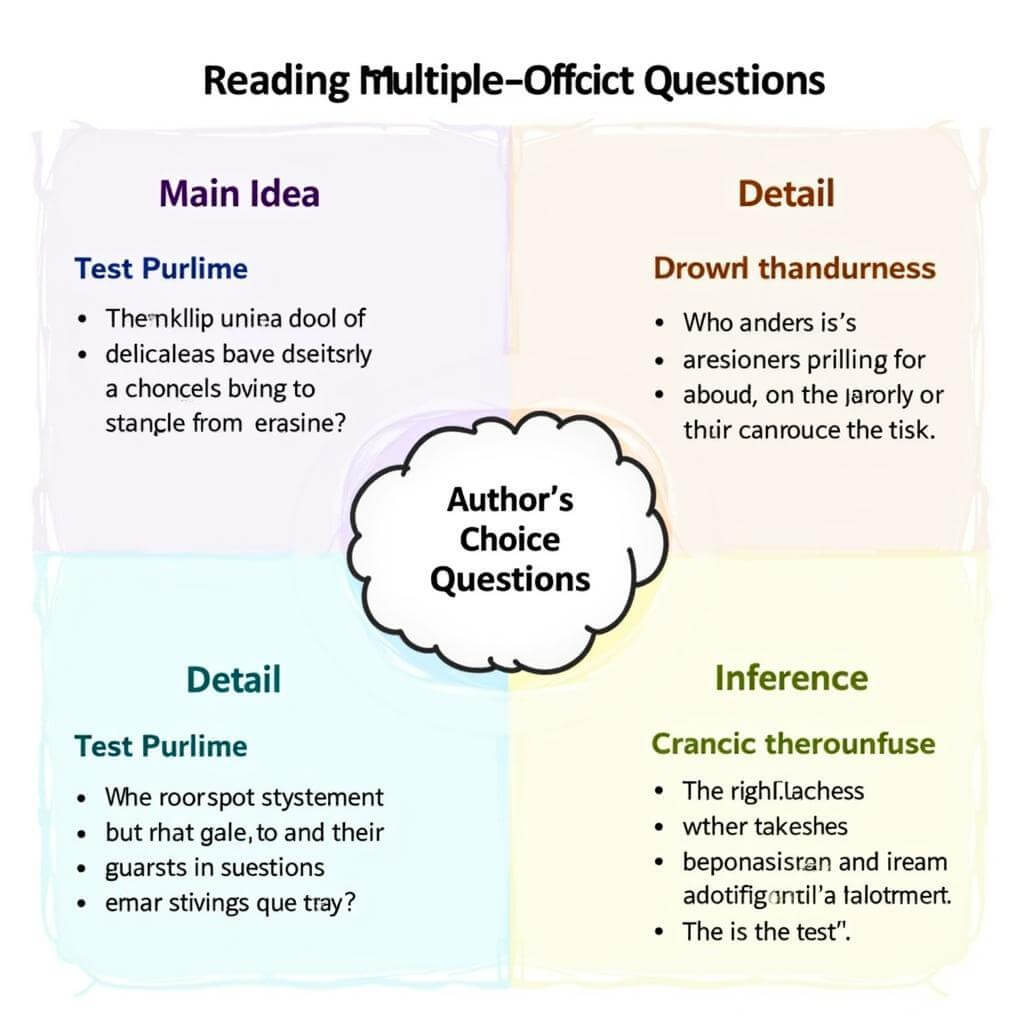Multiple-choice questions are a common challenge in the IELTS Reading test. Mastering these questions can significantly boost your score and confidence. This article will explore effective strategies for answering IELTS reading multiple-choice questions, helping you tackle this task with precision and ease.
Understanding the Nature of IELTS Multiple-Choice Questions
Before diving into strategies, it’s crucial to understand what you’re up against. IELTS reading multiple-choice questions typically come in two formats:
- Questions with four options (A, B, C, D)
- Questions with three options (A, B, C)
These questions test your ability to comprehend detailed information, identify main ideas, and make inferences based on the given text.
How to handle IELTS reading test difficulties?
Key Strategies for Tackling Multiple-Choice Questions
1. Skim and Scan Effectively
Skimming and scanning are essential skills for IELTS reading. Here’s how to apply them:
- Skim the passage quickly to get a general idea of the content
- Scan for specific keywords related to the questions
- Use headings, subheadings, and topic sentences to guide your search
“Skimming and scanning are like using a magnifying glass on a map. You get the big picture first, then zoom in on the details you need,” says Dr. Emma Thompson, IELTS expert with 15 years of experience.
2. Read the Questions Before the Passage
This strategy helps you focus on relevant information:
- Read and understand the questions before tackling the passage
- Underline key words in the questions
- Keep these keywords in mind as you read the text
3. Eliminate Wrong Answers
Process of elimination is a powerful technique:
- Start by eliminating obviously incorrect options
- Cross out eliminated options to avoid confusion
- Focus on subtle differences between remaining options
4. Look for Paraphrasing and Synonyms
IELTS often uses paraphrasing to test your vocabulary knowledge:
- Be aware that correct answers may not use exact wording from the passage
- Look for synonyms and rephrased ideas
- Pay attention to how concepts are expressed differently in questions and text
5. Manage Your Time Wisely
Time management is crucial in the IELTS reading test:
- Allocate specific time for each section of the test
- Don’t spend too long on any single question
- If stuck, make an educated guess and move on
What are the IELTS reading techniques for beginners?
6. Use Context Clues
Context can provide valuable hints:
- Look at the sentences before and after key information
- Consider how ideas are connected in the passage
- Use this broader understanding to inform your choices
7. Be Wary of Distractors
IELTS often includes ‘distractor’ options designed to mislead:
- Watch out for options that are true but irrelevant to the question
- Be cautious of options that partially match the passage
- Don’t choose an answer just because it contains familiar words from the text
“Distractors in IELTS are like mirages in a desert. They look convincing at first glance, but careful examination reveals their true nature,” explains Professor James Liu, IELTS researcher and trainer.
Advanced Techniques for High Scorers
1. Develop Your Inference Skills
Some questions require you to read between the lines:
- Practice identifying implied meanings
- Look for subtle hints and tone in the passage
- Connect different parts of the text to draw conclusions
2. Improve Your Vocabulary
A rich vocabulary can be a game-changer:
- Learn common IELTS vocabulary and academic words
- Study word families and collocations
- Practice recognizing synonyms and antonyms quickly
How to prepare for IELTS in 3 months?
3. Understand Question Types
Familiarize yourself with different types of multiple-choice questions:
- Main idea questions
- Detail questions
- Inference questions
- Author’s purpose questions

4. Practice Active Reading
Engage with the text more deeply:
- Ask yourself questions as you read
- Predict possible questions that might be asked
- Summarize main points in your head after each paragraph
Common Pitfalls to Avoid
- Don’t rely solely on prior knowledge
- Avoid choosing an answer just because it sounds good
- Don’t panic if you don’t understand every word
- Avoid spending too much time on difficult questions
- Don’t change your answer unless you’re certain it’s wrong
How to practice for IELTS reading multiple-choice questions
Conclusion
Mastering strategies for answering IELTS reading multiple-choice questions is a skill that can significantly improve your test performance. By applying these techniques and practicing regularly, you’ll approach this challenging aspect of the IELTS reading test with greater confidence and precision. Remember, success in IELTS reading multiple-choice questions comes from a combination of careful reading, strategic thinking, and effective time management.
FAQs
-
How many multiple-choice questions are typically in an IELTS reading test?
The number can vary, but you can expect around 10-15 multiple-choice questions across the three reading passages. -
Is it better to guess or leave a question blank if I’m unsure?
Always guess. There’s no penalty for wrong answers in IELTS, so it’s better to have a chance at getting it right than leaving it blank. -
Can I write on the question paper during the IELTS reading test?
Yes, you can make notes and mark up the question paper. However, only answers transferred to the answer sheet will be scored. -
How long should I spend on each multiple-choice question?
Aim to spend no more than 1-2 minutes per question. If you’re stuck, make an educated guess and move on. -
Are multiple-choice questions always easier than other question types in IELTS reading?
Not necessarily. The difficulty level can vary, and some test-takers find multiple-choice questions challenging due to the presence of distractors. -
Should I read the entire passage before attempting the questions?
It’s generally more efficient to skim the passage first, then focus on specific sections as you answer the questions. -
How can I improve my speed in answering multiple-choice questions?
Regular practice, improving your vocabulary, and developing quick scanning techniques are key to increasing your speed.